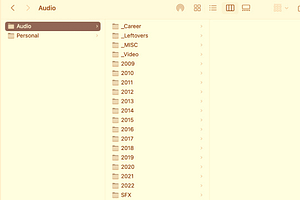
Quick guide to audio file management and naming conventions
I once asked a group of about eight audio makers about file management and the conversation almost ended in a

I once asked a group of about eight audio makers about file management and the conversation almost ended in a fist fight.
It turns out file management is deeply personal. And for good reason; looking into somebody’s file management might be the closest thing to seeing inside their brain.
There are, obviously, many ways to go about managing files.
I will outline my approach below, not to convince you it’s the right way, but to get you thinking. I wouldn’t dare assume my brain would work like yours, but I hope my thinking sparks something for you.
The best file management is the one that works best for you.
The cleanest folder management is no folder management.
Within my folder that contains my edit montage I keep everything on the top level — no audio is separated into folders.
I see this a lot with producers. Within the edit folder there’ll be folders grouped by file type: ‘music’, ‘interviews’, ‘sfx’, ‘archives’, etc. I don’t do this.
I don’t think it’s necessary but also, I think it has the potential to cause problems.
The more folders you have the more unique file paths you’re creating. Which means to keep things clean you’ll inevitably start to move audio between folders. If this happens after you’ve imported the audio to your edit, your edit session will have to go looking for the file to reconnect.
You run the risk of a workflow that is built to serve a folder structure, which is the opposite of what we want.
There’s a time suck to folders within folders. Time to categorise. Time to sort. Time to open up an extra folder every time you go looking for files. Time to reconnect missing files. Creating layers of folders robs you twice — it takes time to set up and adds time later when you have to sift through them all.
Folders begat folders.
The other thing that happens is, if we’re spending a lot of time on folders and categorising, we might get sloppy with our naming convention. This is a major problem because…
The answer to the pursuit of good file management and archiving is being disciplined around your naming convention. Whatever you think about my stance on folders, there is no getting around that fact.
Here is my starting point for a naming convention:
YYMMDD Full Name IV
Date is in reverse order so it appears chronologically in the folder. Full name of guest obviously, and ‘IV’ to tell me it’s an interview. Other tags are ‘ATMOS’ and ‘SFX’. Baking the file category into the file name (instead of a folder) means it can be copied between projects and I will always know what it is.
YYMMDD Street Name ATMOS
YYMMDD Full Name IV ATMOS
YYMMDD Fridge door open SFX
If I have multiple recordings done on the same day, I will number the files so they appear in the order in which they were recorded.
YYMMDD 01 Full Name IV
YYMMDD 02 Full Name IV
YYMMDD 03 Full Name IV
If I’m recording an interview with multiple mics (into the one recorder) I would use this format.
YYMMDD 01 Stacey Chapman IV STACEY SIDE
YYMMDD 02 Stacey Chapman IV MIKE SIDE
If I have multiple recordings on the same day with different microphones a will add a letter to indicate what mic it was on. Eg if I used zoom internal mics I will add Z to the file name.
Notice where I put the letter. It’s just before the number so the clips stay grouped, in their chronological order once they’re in my folder. If the letter was after the number the clips would appear jumbled. I want them to stay grouped by mic type so when I import to my edit session they appear in order.
YYMMDD Z01 Full Name IV
YYMMDD Z02 Full Name IV
YYMMDD Z03 Full Name IV
YYMMDD R01 Full Name IV
YYMMDD R02 Full Name IV
YYMMDD R03 Full Name IV
If I have an interview spread out over multiple clips I will add a number at the end of the clip. I don’t write ‘part 1’ and ‘part 2’ — I just know if there’s a number on the end of the file name it’s part of a bigger series of the same thing.
YYMMDD Z01 Full Name IV 01
YYMMDD Z02 Full Name IV 02
YYMMDD Z03 Full Name IV 03
For zoom recordings, if I have backup files (recorded automatically -10db), generally I will use the exact same file name as the original but add ‘_BU’ to the end of the file name. I might copy all of the backup files into a folder, so if I don’t need any of them I can just delete it later. (yes, I just broke my no-folder-within-a-folder rule — customise your system so it works for you).
YYMMDD Z01 Full Name IV_BU
YYMMDD Z02 Full Name IV_BU
YYMMDD Z03 Full Name IV_BU
A solid naming convention will make searching for files, using the same file across multiple projects, and archiving easy.
My archiving system is split into years — every year has a folder.
Within that year is a project. The project folder has a date on it. So all projects are listed chronologically.
So the doco I made about the Cat Empire in 2021 is titled: ‘211018 The Cat Empire’ and it sits in the folder ‘2021’.
Again, the idea is, less folders = less management.

I once asked a group of about eight audio makers about file management and the conversation almost ended in a

The alleyway is stereotypically dark and long. It’s after 1am, I have no idea where I am and my phone’s about to die.

Here’s what to expect from the ‘Who gives a fork?’ live show touring Aug/Sept 2022.

Jill Beytin, co-founder of Bear Radio, describes where the local scene is at including a juicy story about a recent controversy with one of Germany’s public broadcasters.
get the latest news about upcoming projects:
© 2021 mike williams